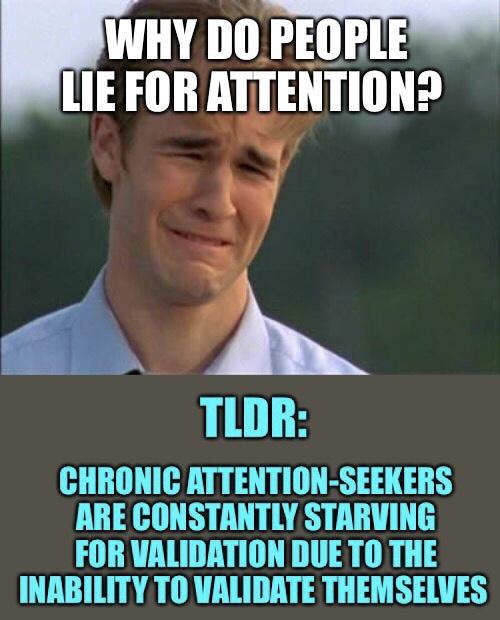
This is going to go into attention-seeking behaviors, and cases of lying FOR ATTENTION, not pathological lying in its entirety. That would be too long.
.
Unfortunately, this is still long. I am sorry. Psychology is not an easy subject to summarize. The TLDR in this meme was the best I could do, but the context is lengthy.
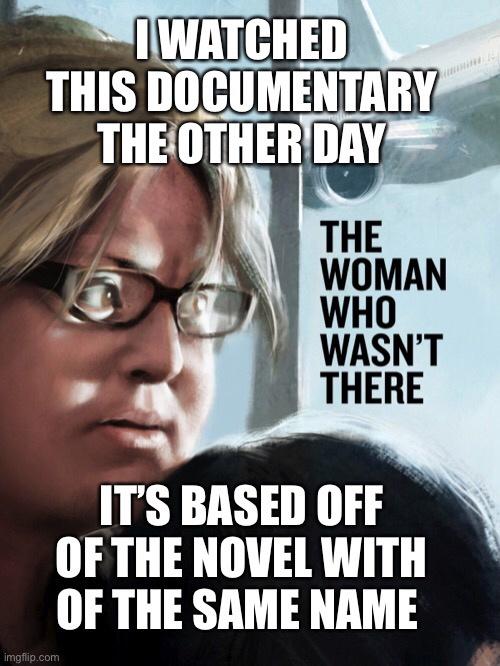
Here’s the link to the trailer: https://youtu.be/UfYQfeLuSrQ
.
I also have a synopsis of the tale of Tania Head in the following image as well.

SYNOPSIS:
.
.
Tania Head was a 9/11 survivor, as well as a 9/11 widow. She had a tragic story of being in one of the top floors of the first tower, and her husband being on the floor below in the second tower. The husband died. Her arm was so mangled, it left serious permanent scars.
.
Tania used her grief to help develop the World Trade Center Survival Network. She managed to get government officials to agree to allow the survivors to visit the depths of the ruins so they could have the closure that they needed.
.
Tania gave tours of the crash site to US public officials. She met with the family of “the man with the red bandana” who saved the lives of so many people before succumbing to his injuries. She wrote eulogies, and diligently organized every event for the survivors of 9/11.
.
.
Her story was both tragic and triumphant. She was a hero… Except that none of her story is true.
.
It was all made up. Tania Head’s real name was Alicia Esteve. She was from Barcelona, Spain, and was attending business school there as well. On 9/11, she was in Spain attending her classes. She made no mention of the terrorist attack. The injury on her arm was from a car crash years prior.
.
Her “husband” was a man that did exist, and was a victim of the 9/11 attacks… but his eulogy made no mention of his alleged fiancé, and his family had never heard of her before.
.
As the documentary and book said, she was the woman who wasn’t there.
.
For those wondering why she wasn’t arrested for this: she did not have any financial gains from a genuine effort to support those who needed it. In other words, while her actions were morally reprehensible, she did not actually commit a crime. Her efforts towards this network were genuine, but it came from an outrageous and untrue tragic story.
.
When her fraud was discovered, “Tania” fled into the night, never to be seen again. She was briefly spotted in 2011 by the man who was finishing up the last bit of filming for the documentary. Apparently, that confrontation did not end well. After that brief incident, she once again vanished into thin air, leaving a million questions in her wake.
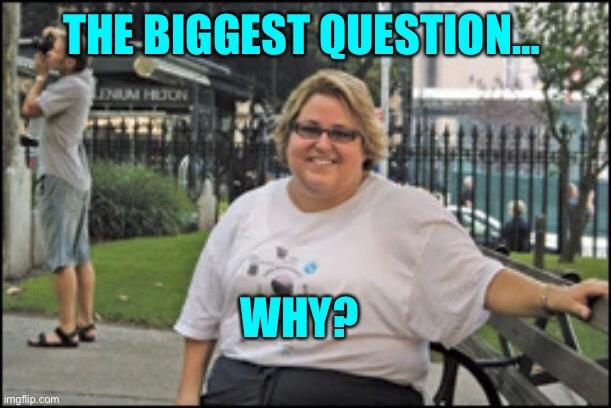
Why lie about enduring such a traumatic experience that no one would wish on their worst enemy?
.
Why did she need to be a “9/11 survivor” to do all of the good she HAD done for the survivors network?
.
Why did she have to lie about her injury? A car crash that nearly severs your arm is horrific enough.

The short answer: She was malingering for attention.
.
“Malingering” is the clinical term for pretending to be sick in order to obtain something or shirk responsibilities.
.
Example 1: A guy who fakes illness so the doctor will sign a recommendation for a day off work is malingering behavior.
.
Example 2: An addict that goes into a hospital making a violent scene, is malingering for pain medication.
.
Example 3: A person that dramatically loses consciousness in a crowd of people for attention, is malingering for attention.
.
Having an entire fabricated life as a 9/11 survivor and widow with severe PTSD in order to gain infamy is most certainly malingering for attention.

It is human nature to try to find an explanation for things we don’t understand. If we can’t find one, we come to our own conclusions that we feel satisfied with. In the medieval days, it was magic, witches, and heretics. In this current age, “sociopathy/narcissism” has been the “catch-all” for damaging behaviors that we can’t understand.

The fifth edition of the Diagnostic Manual of Mental Health Disorders (DSM-5) says that the prevalence of Antisocial Personality Disorder (sociopathy/psychopathy) has been found to range from 0.2% – 3.3%.
.
This is not even remotely close to every single person in the world. There are people that commit damaging behaviors that are not without empathy or conscience. Attention-seeking is more complicated, and it is important that we understand this so we can tackle the issue head on.
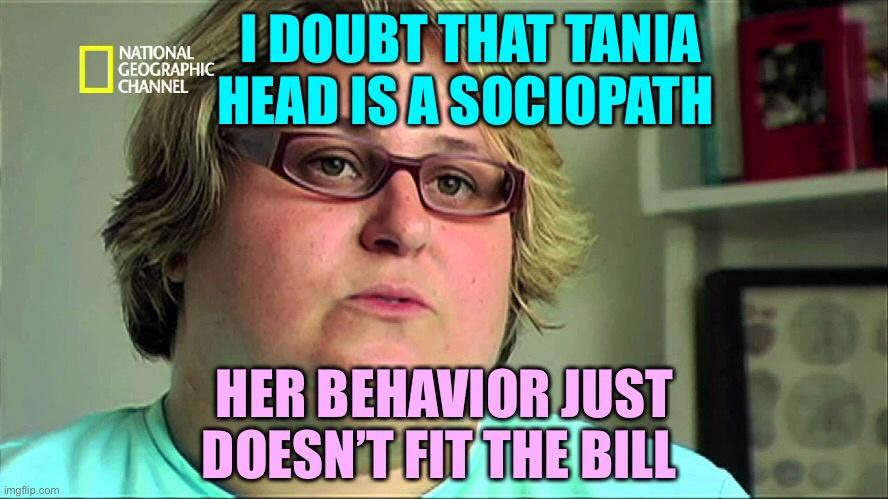
I said before that I have an educational background with Cluster B Personality Disorders. Tania Head does not appear to be motivated motivated by a **callous** disregard for others (attention seeking like this is still a disregard for others regardless of intent). She did not take the money that was being shoved in her face. She did not do the early 2000’s equivalent of a GoFundMe for herself.
.
The big thing: Everything she gained from her fraudulent behaviors, she gave to everyone else. . That is not typical behavior of antisocial personality disorder. That being said, my personal theory is something that could easily be debunked by a forensic psychologist. I am not in any way saying that I know more than a forensic psychologist, but I AM saying that certain types of behaviors make Antisocial Personality Disorder unlikely.

A fancy way of saying “an inability to validate herself.”
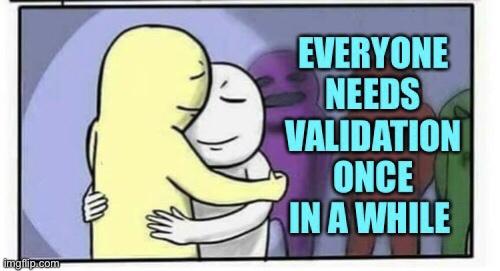
Everyone needs validation every now and then. We need to know that we are human beings that are acknowledged and accepted into our society. We need that sense of “it’s okay to belong.” We make more confident choices when validated.
.
Validation is an essential piece to emotional health. For regular individuals, they are able to emotionally regulate themselves with a normal amount of validation – . Being acknowledged as a good a friend, being recognized for their talents, etc…
.
Then there’s people who can never feel validated. This is especially common in people who suffered abusive childhoods, where their parents/guardians did not give them the necessary amount of validation, acceptance, and nurturing that a child needs.


The Still Face Experiment was a psychological experiment that shows what babies do when they experience neglect by their parents. A mother would play with her baby, and then suddenly give a still face. The baby would go through a cycle of confusion, desperation, and then despair. This is only in the span of a few minutes, so you can imagine the impact this would have on a child who experienced this for 18+ years.
.
You can watch a sliver of the experiment here…
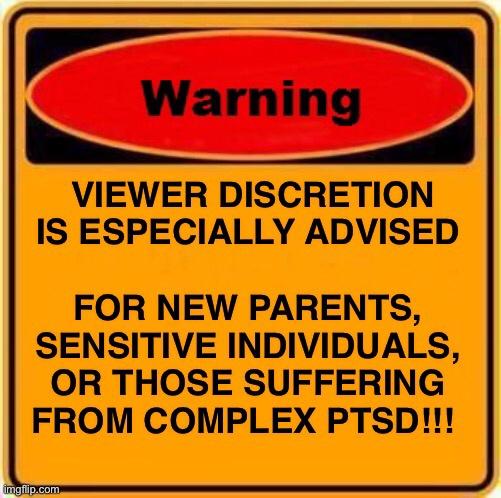
You are going to see a baby in deep emotional distress. You have been warned.
The Still-Face experiment showed what happens when children are neglected. Like I said, they go into confusion, desperation, and despair. This can DEEPLY and PERMANENTLY damage a child.
.
You can watch the full experiment here: https://youtu.be/apzXGEbZht0
Here’s the follow up, because I know it’s hard to watch.
.
The mothers would play with their babies again and everything was fine. No babies were permanently harmed during the experiment, but I applaud the strength of the mothers for being able to do such a difficult task. It was only a few minutes, but it’s so hard to watch a baby feel like that.
.
These mothers’ bravery has helped science develop tools to ensure healthy child development! If you were a participant in the experiment, you deserve a gold medal! Thank you for making such an essential contribution to science!

Unfortunately, not every baby is immediately reengaged. There are millions of children who endure this isolation and neglect for their entire childhood (18 years). This puts them in starvation mode.
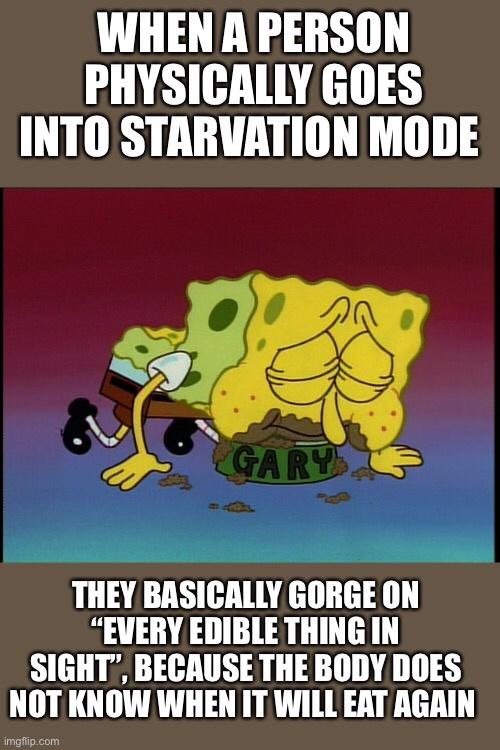
“Everything in sight” is a more dramatic way of describing it. BUT – When the body is in starvation mode, you have this irresistible urge to gorge on food, because your body does not know when it will be eating again. It never feels like enough.

You could eat a lavish ten course meal, but a body in starvation mode will still want more. The appetite is endless.
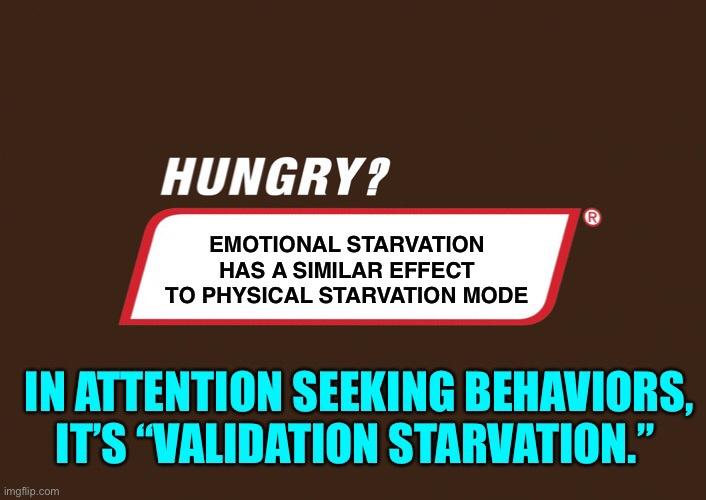
When a child is made to feel invisible, any pinch of visibility is taken, and they do anything the can to get more of it. Their minds are in starvation mode, rather than their body.

These are my personal notes in a theory about understanding and tackling attention-seeking behaviors. Some of these notes are short-handed, so they won’t make any sense without context that isn’t relevant to this post.
.
I just want you to focus on the cycle. That’s the important part in this post.

Studies have shown that negative memories impact the brain more than positive memories. Tragedies garner more attention and sympathy.
.
When someone dies, everyone around them is deeply affected. In fact, a reporter on 9/11 made the observation:
.
“Everyone wanted a piece of 9/11, if we’re being honest. It almost became a religion. It was this desire to connect and be a part of something bigger than ourselves.”
.
There’s truth to this. People respond more intensely to tragedy. For someone that is constantly starving for validation, this is essentially a ten course meal. With this validation, they can finally function again… until it’s not enough anymore.

This model also fits for arrogant narcissists and sociopaths (the ones that have to be better than everyone else). Their “validation meters” are unreasonably high, and they constantly need more and more to feel like it is “enough.”

I believe that this was **probably** Tania’s motivation, just like the motivation of many other people with malingering behaviors. Especially, looking at her background.
.
Tania Head came from a wealthy and highly influential family. She was noted to be spoiled, but she also greatly struggled with her weight, which did a number on her self-esteem. Then her father and brother were tried and convicted of embezzlement, and went to prison for a long time. I believe there was some emotional neglect from her mother to occur after this, but I’m not positive. There WAS neglect, though.
.
The shame that came with the family prompted everyone to pull away. With her father and brother in prison, she didn’t have them around anymore. It was as if the rug had been jerked out from under. Many of her childhood friends testified that Alicia Esteves was never the same after that. When she had her car crash that almost cost her arm, this trauma dug deeper into her.
.
Tania Head was a new identity, and she could gain the spotlight. People would love and accept her again. While my focus is attention seeking, there was also probably an attempt to re-shape her life, and essentially “change” the trauma to something unreal (so she did not have to face the real traumas).
.
Does she have a personality disorder? Probably.
.
– But I REALLY don’t think that it’s antisocial personality disorder, – and I am REALLY not qualified to determine what she actually has . Her behaviors correlate with borderline personality disorder with narcissistic personality traits. This should be taken with as much salt as a large order of McDonald’s fries.
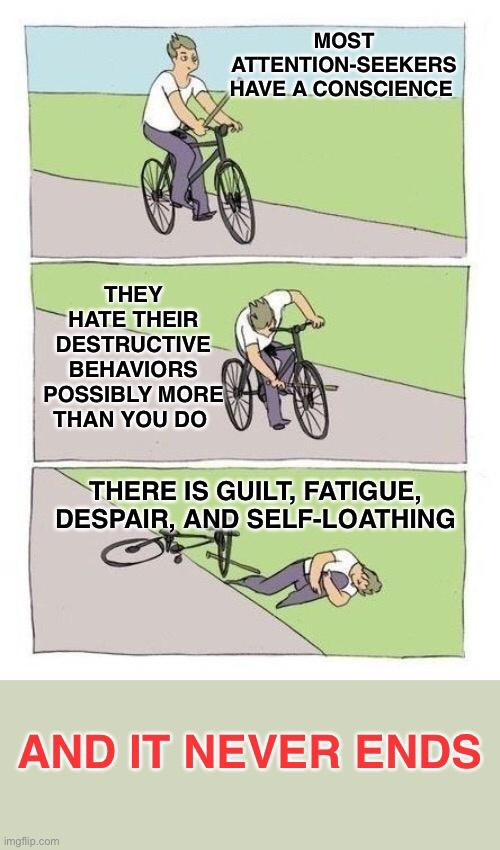
I can’t speak for Alicia Esteves at this point, but I think the following is extremely important to understand chronic attention seeking behaviors.
.
Believe it or not, most attention-seekers are not without conscience. They hate their behaviors as much as you do, possibly even more. This cycle of never being enough is exhausting.
.
It is exhausting to tell so many lies, and have to keep track of them. It is exhausting to not be able to simply exist without doing something that screws someone else over.
.
The guilt of hurting others in order to get your “attention fix” hits you later… but you feel like you can’t stop. You are NOT okay, unless you are constantly in the spotlight.
.
It is a bleak, and miserable existence.

Attention no longer has a high. They just need enough to be able to even function. When the attention fades away, they emotionally shut down and enter starvation mode again.
.
Then they do whatever they can to get their fix, to be okay. It probably comes at the cost of someone else, but that desperation overpowers reason. Then they feel better, and face the damages they caused… and then the cycle repeats itself.
.
Like I said – It is a bleak, and miserable existence. Fortunately, Dialectical Behavioral Therapy has a 75% success rate in treatment of even the most severe of attention seeking behaviors!
.
If anyone reading this uncomfortably resonates with this post, know that there is hope. You are not evil, but you need help. Try to find it if you can.
.
– Go to a physical doctor to make sure it’s not physical (ALWAYS do this first) – When cleared, ask them to refer you to a psychologist/psychiatrist (whichever they think is necessary) – Ask what treatments they recommend, and follow that advice – If you feel like that’s not working, ask about cognitive behavioral therapy (a specific type of talk therapy) . Don’t stop fighting for wellness. You don’t have to live like this. You don’t deserve to live like this. But while I speak to you with empathy and compassion, there is something else that is important to understand.

Actions have consequences. If you hurt someone, they’re allowed to be angry about it.

.
An alcoholic drinks, drives, and kills someone. They go to prison for murder. An attention-seeker ruins someone’s life, or traumatizes someone else, they face criminal or social consequences.
.
Empathy is NOT a “get out of jail” card. I’m only trying to make such baffling behavior more comprehensible. We need to stop defaulting this to sociopathy. We need to tackle it at its source.
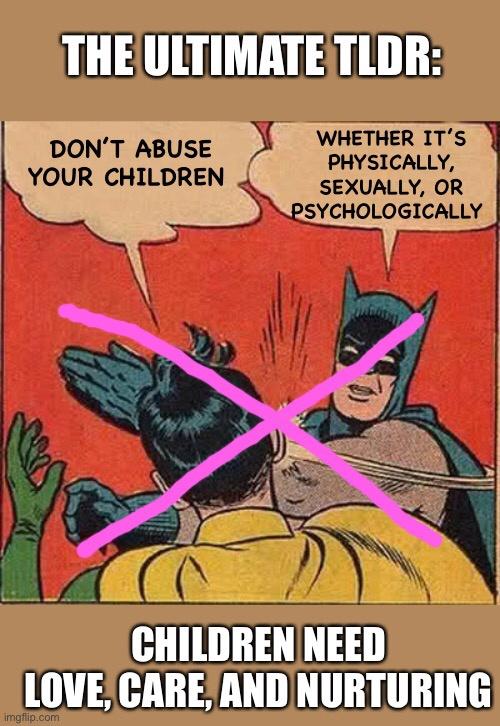
Alicia Esteves’ situation was different from typical childhood neglect, but she still endured a period of neglect and abandonment.
.
If children are unnurtured, they might grow up to find happiness in being a 9/11 survivor and a widow, or a cancer patient, or a victim of countless other tragedies.
.
It is extremely disturbing to find happiness in being a tragic character, and that’s what emotional abuse and neglect can do to a child.
.
DON’T ABUSE YOUR CHILDREN.